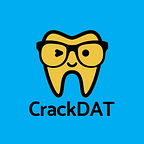Top tips for tackling general and organic chemistry on the DAT
This pre-dental blog is brought to you by Crack the DAT. Crack the DAT offers all the resources you need to ace your Dental Admission Test, all in one place! Try it today: CrackDAT.com
Whether you thrived in or dreaded college chemistry class, you will (for better or for worse) need to be proficient in this subject to do well on the Dental Admission Test (DAT)! The Survey of Natural Sciences, the very first section of the DAT, includes 100 questions covering biology, general chemistry, and organic chemistry. In this article, we share five top tips for approaching the chemistry component of the DAT to help you do your best with these important subjects. Read on!
1. Start with a general overview of the content.
This is the best way to refresh your memory of any topics you likely learned in your college general and organic chemistry classes, but may have since forgotten. All of the topics you’ll need to know to be successful on the DAT are covered in CrackDAT’s video crash courses and cheat sheets. Use whichever review method works best for you and your learning style. As you complete your content review phase, make sure you’re using active learning strategies — that is, taking notes, making summary sheets, pausing to check your understanding periodically, etc. — to make sure you’re understanding what you’re reading or watching.
2. Download (or create your own) “cheat sheets.”
General chemistry is full of formulas and topics to memorize. What are the most important gas formulas? What constants (e.g., Avogadro’s number) do you need to know? What are the strong acids and bases? What are the units of the rate constant k for reactions of various orders?
Organic chemistry has its own set of information to memorize, including reaction mechanisms and standard naming conventions. As you review the chemistry content, compile these topics to memorize in one organized place so that you can review them easily and boost your ability to commit everything to memory. You can also download several pre-made “cheat sheets,” like these on the CrackDAT site, to supplement your own:
3. Do practice problems, practice problems, practice problems!
This is, undoubtedly, the best way to prepare yourself for the chemistry questions on the DAT. You need to expose yourself to a wide variety of question types and get familiar with everything you might see on test day. With chemistry, it’s especially important to be methodical in your approach to every question. For example, every time you do a general chemistry acid-base question, you might start by ensuring you have a balanced chemical reaction first, then writing down any formulas you need, then determining how to solve (can I just plug in values, or do I need to set up an ICE table?) As always, be sure you’re making time to review your mistakes every time you do a practice test. By understanding why you made a mistake, you are less likely to repeat it in the future.
Tip: Be careful with units when you’re solving chemistry problems! Make sure you have the appropriate units (for example — Kelvin and atm, when solving a question at standard temperature and pressure) before solving. This can prevent you from choosing the incorrect answer, even if your method of solving was correct!
4. Focus on high-yield topics.
On the general chemistry section, you will need to be able to simplify without using a calculator — you will only be provided with a simple on-screen calculator during the Quantitative Reasoning, or QR, section. That means it’s worth your while you get extremely comfortable with simplification and exponent rules because this will help you with general chemistry and QR!
Additionally, some topics overlap between general and organic chemistry. For example, both sections include questions about acids and bases, as well as chemistry lab techniques. Spending plenty of time reviewing and practicing topics that show up on various sections of the DAT often pays off.
5. When in doubt, use your testing strategies.
Don’t forget about tried and true testing strategies like process of elimination. Let’s look at the following question:
Which of the following ionic solids is most likely blue?
A. BaSO4
B. AgCl
C. CuSO4
D. KI
E. Li2SO4
Even if you have no idea how to approach this question, you can use the answer choices to help you spot some similarities and differences. For example, all of the answer choices contain Group I and II metals (Ba, K, Li) except for answers B and C, which contain transition metals (Ag, Cu). You may remember learning something about transition metals and color, so even if you’re not 100% sure, you can at least eliminate three answer choices, leaving yourself with a 50/50 chance of guessing correctly! (If you’re curious, the answer to this question is C.)
Strategies like this can boost your scores on the general and organic chemistry sections. Other strategies, such as writing down formulas that may come in handy, can also help you get started on a question that initially has you stumped.
We hope this advice helps! Chemistry may seem daunting, but like all sections of the DAT, it comes down to practicing and believing in yourself! We wish you the best of luck.
—
Join the Crack the DAT community, connect with other pre-dental students, and ask questions! Join the Facebook group here.
Crack your Dental Admission Test! Visit our website at CrackDAT.com.
